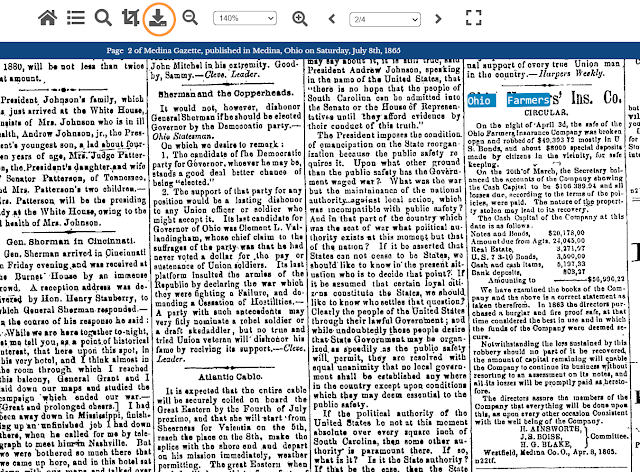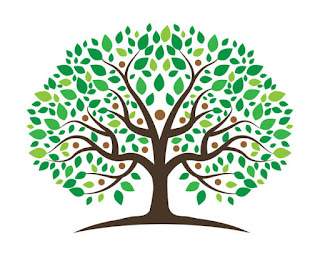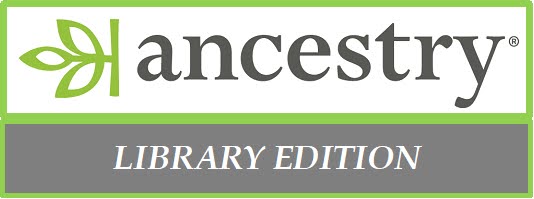Many people think genealogy research is just about finding the basic information for their ancestors, i.e. birth, marriage and death records. However, if their research stops there they are missing out on a large part of their ancestor’s life. Finding out about the events which occurred between those dates makes it a family history instead of just a family tree...with all branches and no leaves.
Since it is February and we celebrate President’s day on the 15th, I thought I would illustrate what I mean by using the Ohio men who became President to show how there is so much more to them than just the dates.
First, I will give the basic information - The BRANCHES of the Tree
Then I will add to this information with a little more details of the President's life - The LEAVES of the Tree
William Henry Harrison – 9th President
BRANCHES:
Birth: 9 February 1773
Marriage: 25 November 1795
Death: 4 April 1841
 |
Harrison's Land Record from www.glorecords.blm.gov
|
LEAVES:
Harrison was not born in Ohio. He was actually born in Charles City County, Virginia. Ohio claims him as one of theirs, because he settled in Hamilton County, Ohio along the Ohio River early in the state’s history and was living there when he became President. He was also the last President born before the United States became independent.
He married Anna Tuthill Symmes in Hamilton County. However…when he asked Anna’s father, John Symmes, for permission, her father refused. William and Anna had to elope and marry in secret.
Harrison became President on the 4th of March 1841 and delivered a 1 hour and 40 minute inaugural address, the longest in history, in wet and chilly weather. Tragically, he became ill after the inauguration and died 31 days later in Washington D.C. He was the first President to die in office.

Ulysses S. Grant – 18th President
BRANCHES:
Birth: 22 April 1822
Marriage: 22 August 1848
Death: 23 July 1885
LEAVES:
Grant was born in Clermont County, Ohio, a town along the Ohio River. It took his parents over a month to name him. They finally named him Hiram Ulysses. However….the Representative that arranged for his appointment to West Point, submitted his name as Ulysses Simpson Grant. He was never able to get the academy to fix it and supposedly he didn’t care for his original initials, H.U.G., so he just continued to use his new name.
 |
| Grant & Dent Marriage Record |
He was introduced to his future wife, Julia Boggs Dent, through her brother who went to West Point with him. There is a story that Grant was riding in a carriage with her and came to bridge where the river was flooding. He assured her he would safely get her across, but she said she would still cling to him no matter what. When they successfully crossed he asked her if she would "cling to him the rest of their lives". He married Julia in St. Louis, Missouri at her family’s plantation. Grant’s parents were so unhappy that he was marrying into a family who held slaves they did not attend the wedding.
President Grant was in office for two terms, 1869-1877. During his time as President, he supported amnesty for Confederate leaders and protections of the rights of African-Americans. He also signed legislation making Yellowstone National Park one of America’s first national parks.
Ulysses S. Grant died in Saratoga County, New York from throat cancer. An estimated 1 million persons turned out for his funeral procession. He was temporarily laid to rest near Sarasota Springs, but in 1897, President McKinley had him buried in New York City overlooking the Hudson River.

Rutherford B. Hayes – 19th President
BRANCHES:
Birth: 4 October 1822
Marriage: 30 December 1852
LEAVES:
Hayes was born, two months after his father’s death, in Delaware County, Ohio. He was raised by his mother and his maternal uncle.
 |
RB Hayes Obituary
|
He married Lucy Ware Webb in Cincinnati. She was a college graduate from Wesleyan Women’s College making her the first First Lady to have graduated from college.
Hayes won the 1876 election after a special commission was formed to investigate disputed electoral votes. The tension was so high he had to secretly take the oath of office in the Red Room at the White House.
As President, he was a proponent of civil rights and education for all. He also signed a bill that allowed female attorneys to argue cases before the U.S. Supreme court. Hayes followed through on his pre-election promise of only serving one term.
R.B. Hayes died at his home in Fremont, Sandusky, Ohio. He caught a chill on a train ride from Columbus to Cleveland where he then suffered a heart attack. He made it back to his home where he died a few days later.
James A. Garfield – 20th President
BRANCHES:
Birth: 19 November 1831
Marriage: 11 November 1858
Death: 19 September 1881
LEAVES:
 |
U. S. Civil War Index
|
Garfield was born in Cuyahoga County, Ohio in a log cabin built by his father. He had a rough childhood, losing his father early and living in poverty with his mother.
While a student at Williams College in Massachusetts he dated two women at the same time, Rebecca Selleck and Lucretia Randolph. Garfield ended up marrying Lucretia in Hiram, Ohio. During the Civil War he began as a lieutenant-colonel for the 42nd Ohio Volunteer Infantry and fought in the battles of Shiloh and Chickamunga. He resigned with the rank of major general.
Garfield did not accomplish much as President because he was assassinated four months into term. He was shot by Charles J. Guiteau, who tried and failed to get a position under Garfield’s administration. The President died two months later in Elberon, New Jersey where he was taken upon his request. Some believe he died due to the unsanitary methods of removing the bullet by the doctors. Alexander Graham Bell, the inventor of the telephone, tried unsuccessfully to locate the bullet with a metal detector he invented.
Benjamin Harrison - 23rd President
BRANCHES:
Birth: 20 August 1833
Marriage: 20 October 1853
6 April 1896
Death: 13 March 1901
LEAVES:
Harrison, the grandson of former President William H. Harrison, was born in his grandfather’s home in Hamilton County, Ohio.
He married Caroline Lavinia Scott at her home in Oxford, Ohio. They had been secretly engaged in 1852, but she wanted to finish her education while he studied law. They were married by her father, Reverend John W. Scott. Caroline died of tuberculosis on 25 October 1892, two weeks before the election for Harrison’s 2nd term.
Almost 4 years later Harrison married Mary Scott Lord Dimmick in New York City. She was a widow, 25 years younger than him and his late wife’s niece. His children from his first marriage were extremely upset and did not show up for the wedding.
While President, Harrison appointed the first African-American to a high ranking role in government. He appointed Frederick Douglas, a former slave, as minister to Haiti in 1889.
 |
Death Certificate
|
Harrison died from pneumonia in Indianapolis, Indiana and is buried there next to his first wife at Crown Hill Cemetery. A bulk of his estate went to his second wife and their daughter, but due to the bad relationship with his older children, a much smaller amount was allotted to them.
William McKinley – 25th President
BRANCHES:
Birth: 29 January 1843
Marriage: 25 January 1871
Death: 14 September 1901
LEAVES:
William McKinley was born Trumbull County, Ohio and later his family moved to Mahoning County, Ohio. He enrolled in the Union Army at the outbreak of the Civil War and by the end was a major.
He married Ida Saxton in Canton, Ohio where they lived until his Presidency. Ida began having epileptic seizures and considered an invalid the rest of her life. McKinley took such good care of her in private and in public, that it was remarked that he was making it pretty hard for the other husbands in Washington D.C.
 |
Leon Czolgosz
|
The Spanish-American War was fought during McKinley’s Presidency. The war lasted 3 months with America being the victors. Because of this and the improving economy, he won his second term election.
To celebrate the victory he began a cross-country trip. One of his stops was in Buffalo, New York, where he was assassinated by Leon Czolgosz. Czolgosz had wrapped his hand in a bandage where he hid a revolver. As McKinley went to greet him, he shot him twice.
William Taft – 27th President
BRANCHES:
Birth: 15 September 1857
Marriage: 19 June 1886
Death: 8 March 1930
LEAVES:
 |
Taft and Herron marriage record
|
William Taft was born in Cincinnati, Ohio where he married Helen Herron.
Taft was President from 1909-1913. While living in the White House he got stuck in the bathtub due to his large size and had to have a special tub made for him.
He was the first President to throw the first pitch of the baseball season and the first to own a car.
In 1921, Taft was appointed to the Supreme Court. With this appointment he became the only person to hold a position in both the Executive and Judicial branches of the U.S. and was also the only former president to swear in an incoming President.
William Taft died at his home in Washington, D.C. His funeral was the first to be broadcast over the radio. He was buried in Arlington National Cemetery with John F. Kennedy being the only other President buried there.
Warren Harding – 29th President
BRANCHES:
Birth: 2 November 1865
Marriage: 8 July 1891
Death: 2 August 1923
LEAVES:
 |
18 Feb 1911
|
Warren Harding was born in Corsica, Morrow County, Ohio. As a young man he was a Newspaper Publisher in Marion, Ohio. His Newspaper, The Marion Weekly Star, did not do well in the beginning. However, once Harding married a young divorcee, Florence Kling De Wolfe, the paper’s success began to grow. She helped with the financial end of the business and was able to make it a profitable endeavor.
Harding won the 1920 presidential election and became the first sitting-senator in American history to win the Presidential election. He was also the first president elected after women were given the right to vote. Two years into his term he decided to take a tour of the United States and became the first President to visit Alaska. However, when he reached San Francisco, California he was not feeling well and was diagnosed with pneumonia. A few days later he was feeling better, but unexpectedly died on the evening of August 2nd. Some say he died of a stroke, others a heart attack and a few others….poison...but that's even longer story...
Now...without scrolling back up to the top... how many of the birth, marriage and death dates do you remember?
How much of the "LEAVES" information do you recall?
I hope this clearly illustrates how additional information helps form a memorable picture of the people that are being researched. How it will make your ancestors come to life and give a greater significance to your family history....to have a beautiful family tree with branches full of leaves!
If you want to pursue your research beyond the dates, keep reading our blog to learn the different techniques and resources you can use to add the stories to your family history. You can also contact us at the Virginia Wheeler Martin Family History & Learning Center by emailing us at: me-team.genealogy@mcdl.info or call 330-725-0588 x 5017.
Sources:
William A. DeGregorio with updates by Sandra Lee Stuart, The Complete Book of U.S. Presidents, 8th Edition, (Fort Lee, NJ: Barricade Books, Inc., 2012).
Ohio History Central, www.ohiohistorycentral.org.
Duksters, www.dusksters.com/biography/uspresidents.
Rutherford B. Hayes Library and Museum, www.rbhayes.org/hayes/biography/.
Ohio Secretary of State, www.ohiosos.gov/profile-ohio/people/ohio-presidents.
.
Family Search, www.familysearch.org.
Ancestry Library Edition, www.AncestryLibrary.com, accessed through library database.
Newspaper Archives, https://access.newspaperarchive.com/, accessed through library database.
Newspapers.com - World Collection, https://newscomwc.newspapers.com/, accessed through library .
database.
U.S. Department of the Interior, Bureau of Land Management, General Land Office Records, https://glorecords.blm.gov
The White House, https://www.whitehouse.gov/about-the-white-house/presidents/.
Ohio Memory Collection, https://ohiomemory.org/digital/collection/.














































